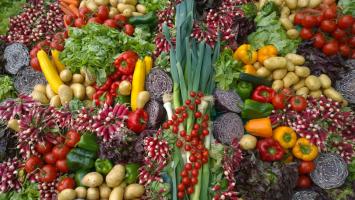Roasted Artichoke With Fenugreek, Lemon & Olive Oil |
![Save this Recipe. Save this Recipe]() Save Save
How to Make Roasted Artichoke with Fenugreek, Lemon & Olive OilSERVINGS: 4 PREP TIME: 10 MINUTES COOK TIME: 45 MINUTES SKILL LEVEL: MEDIUM
INGREDIENTSSKILL LEVEL: MEDIUM
| 4 whole | |
| 2 pinch | |
| 1 tsp | |
| 1 clove | |
| 1 whole | |
| 1/4 c | |
PREPARATION OF THIS HEALTHY RECIPE
1. Preheat oven to 400F.
2. Warm olive oil in a pan, and add minced garlic and ground fenugreek.
3. Cook gently for 5 minutes and set aside.
4. Prepare artichoke by cutting about 1/2 inch from the head, and peeling the stem.
5. Tear away the tough outer leaves until you get to the softer inner green leaves.
6. Cut the artichoke in half lengthways, and scrape out the inner "fuzzy" chokes with a spoon.
7. Take each artichoke half and place on an individual square sheet of aluminum foil.
8. Immediately pour the olive oil, garlic, and fenugreek over each artichoke half, and fold the aluminium foil over to create a pouch with the artichoke inside.
9. Roast for in oven dish lined with parchment paper for 40 minutes.
10. Remove each artichoke from their foil pouch, squeeze fresh lemon juice on top and add a pinch of black pepper before serving.
Preparation notes:
Artichokes discolor quickly, so are best prepared immediately before cooking. If preparing in advance, place them in a bowl of water with lemon juice to prevent discoloration.
These roasted artichokes are a great spring cleanse side dish.
AYURVEDA'S GUIDE TO VITALITY & WHOLESOME NOURISHMENT
Your Ayurvedic diet is tailored to your individual body and your specific imbalances.
With an Ayurvedic diet you feel joy and satisfaction because what you are eating truly nourishes and balances you.
Disease results from diets and lifestyles that are incompatible with your nature.
By eating a personalized diet matched to your body, you experience optimal health.
See How it Works.
Is Roasted Artichoke with Fenugreek, Lemon & Olive Oil Good for My Ayurvedic Diet?
Find out by taking this free, easy quiz.
You'll learn your body type, and whether 'Roasted Artichoke with Fenugreek, Lemon & Olive Oil' is a good fit.
Complete the basic quiz in 1 minute, or go deeper with additional quizzes at your own leisure to learn more about your body.
See a complete list of all biocharacteristics.
INCREASES![Guna Help]()
Increases These Biocharacteristics (Gunas)
Functional Ayurveda helps you assess imbalances through 20 main biocharacteristics
(gunas).
Aggravating these characteristics weakens your body and causes imbalance.
By knowing which characteristics are habitually imbalanced in your body, you will be able to identify and correct imbalances before you get sick.
Every characteristic has an opposite which balances it (i.e. hot balances cold).
You restore balance by favoring diet and lifestyle choices that increase the opposite characteristic.
Learn More
| LIQUEFIED ![Liquefied Liquefied]() ABOUT LIQUEFIED BIOCHARACTERISTIC ABOUT LIQUEFIED BIOCHARACTERISTIC
Substances that thin fluids (lower viscosity of blood plasma). These may include blood thinners or mucolytic herbs.
LEARN MORE ABOUT LIQUEFIED HOT ![Hot Hot]() ABOUT HOT BIOCHARACTERISTIC ABOUT HOT BIOCHARACTERISTIC
Hot is identified by increased body temperature, metabolism, or inflammation.
LEARN MORE ABOUT HOT MOBILE ![Mobile Mobile]() ABOUT MOBILE BIOCHARACTERISTIC ABOUT MOBILE BIOCHARACTERISTIC
Mobile refers to anything that stimulates the nervous system, muscles, or activity.
LEARN MORE ABOUT MOBILE DRY ![Dry Dry]() ABOUT DRY BIOCHARACTERISTIC ABOUT DRY BIOCHARACTERISTIC
Dry is identified by lack of moisture, lack of fat, or anything that causes diuresis.
LEARN MORE ABOUT DRY CLEAR ![Clear Clear]() ABOUT CLEAR BIOCHARACTERISTIC ABOUT CLEAR BIOCHARACTERISTIC
Clear refers to anything that cleanses or flushes out wastes, or that digests ama.
LEARN MORE ABOUT CLEAR | TASTES![Taste Help]()
The 6 Tastes
Taste is used to sense the most basic properties and effects of food.
Each taste has a specific medicinal effect on your body.
Cravings for food with certain tastes indicate your body is craving specific medicinal results from food.
Taste is experienced on the tongue and represents your body's reaction to foods.
Sweet taste causes physical satisfaction and attraction whereas bitter taste causes discomfort and aversion.
Kapha should use less sweet taste while Vata and Pitta would benefit from using more sweet taste.
One of the first signs of illness is that your taste and appetite for food changes.
The six tastes are sweet, sour, salty, pungent, bitter, and astringent.
Do you crave foods with any of the tastes below?
Learn More
| BITTER ![Bitter Bitter]() ABOUT BITTER BIOCHARACTERISTIC ABOUT BITTER BIOCHARACTERISTIC
Bitter taste has cholagogue action - it is cold, clear, light, and stimulating. It increases digestive enzymes, laxative, and drying.
LEARN MORE ABOUT BITTER ASTRINGENT ![Astringent Astringent]() ABOUT ASTRINGENT BIOCHARACTERISTIC ABOUT ASTRINGENT BIOCHARACTERISTIC
Astringency is characterized by constriction, drawing together, or drying.
LEARN MORE ABOUT ASTRINGENT PUNGENT ![Pungent Pungent]() ABOUT PUNGENT BIOCHARACTERISTIC ABOUT PUNGENT BIOCHARACTERISTIC
Pungency is characterized by irritation, or sharp, spicy foods that irritate the mouth such as black pepper.
LEARN MORE ABOUT PUNGENT | DOSHAS![Dosha Help]()
The Three Doshas / Body Types
According to the biocharacteristic theory of medicine,
people tend to get sick, over and over again, due to habitual causes and imbalances that are unique to the person.
Your body type summarizes this tendency, showing you the 'type' of conditions and imbalances that frequently challenge your health & wellness.
Using body type, you can also identify remedies likely to improve your strength and resiliency.
Your body type identifies physical and mental characteristics as well as your personal strengths and weaknesses.
The calculation of your body type is based on your medical history.
The 3 functional body types
(doshas),
are Catabolic (Vata), Metabolic (Pitta), and Anabolic (Kapha).
Catabolic individuals tend to break down body mass into energy. They are easily stimulated, hyperactive, underweight and dry.
Metabolic individuals tend to burn or use energy. They tend to be rosy-cheeked, easily irritated, focused, driven, and easily inflamed.
Anabolic individuals tend to store energy as body mass. If they store too much energy, they could gain weight easily and have congestion. Anabolic people tend to be stable and grounded.
Learn More
| | HAS THE FOLLOWING | Subtaste:
Aromatic AROMATIC
Herbs or spices with volatile essential oils that present strong aromas. Aromatic oils shock, refresh and numb tissue, with the end result of relaxing, opening and clearing stagnant fluids in tissues.
SEE ALL 'AROMATIC' FOODS / HERBS , Bland BLAND
Bland means doesn't have much taste. In Chinese medicine, bland taste refers to afood without little macronutrients, such as cabbage, radish or bok choy.
SEE ALL 'BLAND' FOODS / HERBS
Tissue (dhatu):
, ,
Family:
Asteraceae |
|
Medicinal Benefits, Uses & Herbal Actions of Roasted Artichoke with Fenugreek, Lemon & Olive Oil ![Help]() Experiences are Personal
Experiences vary according to the person and constitution. Individual results may vary.
The list of herbal-actions below has not be approved by the FDA and should not be used to treat a medical condition.
, , Sialogogue SIALOGOGUE
A sialogogue increases saliva. Sour foods are often great sialogogues, and increase output of all exocrine glands. Salty taste is very moistening as well. Bitter, pungent and sweettastes also increase salivary output but to a
lesser degree. Astringents.
SEE ALL 'SIALOGOGUE' FOODS / HERBS , Carminative CARMINATIVE
Stimulates the release of gas. Helpful for bloating or cramping abdominal pain. Propels food downward. Carminatives typically expel gas by relaxing the muscles of the intestines.
SEE ALL 'CARMINATIVE' FOODS / HERBS , High Fiber Laxative HIGH-FIBER-LAXATIVE
A class of laxative that adds bulk and water to stools. The large size of the stool stimulates peristalsis so the stool can pass more easily through the colon. It is important to drink plenty of water when using high fiber laxatives, as they can be dehydr
SEE ALL 'HIGH-FIBER-LAXATIVE' FOODS / HERBS Expectorant EXPECTORANT
Expectorants help you eliminate mucus from the lungs. These herbs often work by increasing the quantity of mucus, or thinning the mucus. Expectorants are indicated when phlegm congests the lower respiratory tract.
SEE ALL 'EXPECTORANT' FOODS / HERBS Calms Heart CALMS-HEART
An herb that literally calms the heart. These herbs are helpful in the treatment of anxiety, sadness, depression, or other emotional imbalances in the heart. Related to the Chinese Herbal Category 'calms spirit.'
SEE ALL 'CALMS-HEART' FOODS / HERBS Diuretic DIURETIC
Herbs that promote urine formation, thereby flushing the kidneys and urinary tract while eliminating any excess water retention. As diuretics reduce water retention, they are often used to reduce blood pressure.
SEE ALL 'DIURETIC' FOODS / HERBS Cholagogue CHOLAGOGUE
Cholagogues stimulate the production & release of bile from the liver & gallbladder. This refreshes and cleanses these organs, as well as increases bile in the small intestines.
SEE ALL 'CHOLAGOGUE' FOODS / HERBS , Hepatoprotective HEPATOPROTECTIVE
An herb that is capable of preventing liver damage. Many hepatoprotectives work via antioxidant and anti-inflammatory properties.
SEE ALL 'HEPATOPROTECTIVE' FOODS / HERBS Hypolipidemic HYPOLIPIDEMIC
Scrapes fats / cleanses blood vessels by 1) purging bile, 2) strengthening the liver's ability to metabolize fats, 3) by increasing uptake of cholesterol in the liver, and 4) by inhibiting fat cells.
SEE ALL 'HYPOLIPIDEMIC' FOODS / HERBS , Constituents: Saponin, , Inositol INOSITOL
Inositol is an alcohol sugar made naturally in the human body from glucose. It is lipotropic (aiding fat metabilism in the liver). It affects a variety of hormones, neurotransmitters, steroid, growth factors and water.
SEE ALL 'INOSITOL' FOODS / HERBS , , , , Rutin RUTIN
Rutin is a flavonoid with anti-oxidant, anti-inflammatory and anti-cancer properties. Commonly used to treat conditions such as varicose veins, hemorrhoids, and high blood pressure.
SEE ALL 'RUTIN' FOODS / HERBS , Tannins, Nitric Oxide NITRIC-OXIDE
Improves circulation by dilating blood vessels. Protects blood vessels from damage. Improves athletic performance, libido, immunity, and brain health.
SEE ALL 'NITRIC-OXIDE' FOODS / HERBS , , , Soluble Fiber, Flavonoids FLAVONOIDS
Flavonoids are a colorful type of polyphenol. As all polyphenols, they have a strong antioxidant effect. Many flavonoids have an anti-inflammatory, and/or antiallergen effect.
SEE ALL 'FLAVONOIDS' FOODS / HERBS , Fats |
Foods with a Similar Nature to Roasted Artichoke with Fenugreek, Lemon & Olive Oil
Lemon
Lemon has these Actions in Common
Carminative, Digestive, Quenches-thirst, Sialogogue, Cholagogue, Expectorant, Refreshes-skin, Calms-heart, Diaphoretic, Internal-detoxicant, Relaxes-eyes
LEARN MORE
Fenugreek
Fenugreek has these Actions in Common
Cholagogue, Diuretic, Internal-detoxicant, Burns-toxins, Diaphoretic, Expectorant, Lowers-blood-sugar, Carminative, Digestive, Hypolipidemic, Stimulates-energy
LEARN MORE
Dandelion Leaves
Dandelion Leaves has these Actions in Common
Diuretic, Internal-detoxicant, Stimulates-peristalsis, Cholagogue, Hepatoprotective, Lowers-blood-sugar, Digestive, Hypolipidemic, Stimulates-energy
LEARN MORE
Cinnamon
Cinnamon has these Actions in Common
Digestive, Internal-detoxicant, Carminative, Diuretic, Lowers-blood-sugar, Diaphoretic, Expectorant, Stimulates-energy, Burns-toxins
LEARN MORE
Grapefruit
Grapefruit has these Actions in Common
Hypolipidemic, Sialogogue, Cholagogue, Internal-detoxicant, Stimulates-energy, Expectorant, Quenches-thirst, Stimulates-peristalsis
LEARN MORE
Dill
Dill has these Actions in Common
Diaphoretic, Expectorant, Burns-toxins, Digestive, Internal-detoxicant, Carminative, Diuretic, Stimulates-energy
LEARN MORE
Cardamom
Cardamom has these Actions in Common
Carminative, Diuretic, Stimulates-energy, Diaphoretic, Expectorant, Burns-toxins, Digestive, Internal-detoxicant
LEARN MORE
Nigella (black cumin)
Nigella (black cumin) has these Actions in Common
Carminative, Diuretic, Stimulates-energy, Diaphoretic, Internal-detoxicant, Burns-toxins, Digestive, Lowers-blood-sugar
LEARN MORE
Cilantro
Cilantro has these Actions in Common
Stimulates-energy, Cholagogue, Hypolipidemic, Burns-toxins, Digestive, Internal-detoxicant, Carminative, Diuretic
LEARN MORE
Ginger (Fresh)
Ginger (Fresh) has these Actions in Common
Digestive, Internal-detoxicant, Burns-toxins, Hepatoprotective, Sialogogue, Carminative, Hypolipidemic, Stimulates-energy
LEARN MORE
Turmeric Root (Fresh)
Turmeric Root (Fresh) has these Actions in Common
Cholagogue, Hypolipidemic, Burns-toxins, Digestive, Internal-detoxicant, Carminative, Hepatoprotective, Lowers-blood-sugar
LEARN MORE
Herb Supplements with a Similar Nature to Roasted Artichoke with Fenugreek, Lemon & Olive Oil
Amalaki
Amalaki has these Actions in Common
Digestive, Hepatoprotective, Internal-detoxicant, Lowers-blood-sugar, Quenches-thirst, Relaxes-eyes, Sialogogue, Stimulates-energy, Carminative
LEARN MORE
Wild Ginger
Wild Ginger has these Actions in Common
Burns-toxins, Carminative, Diaphoretic, Digestive, Expectorant, Internal-detoxicant, Sialogogue, Stimulates-energy
LEARN MORE
Dong Quai
Dong Quai has these Actions in Common
Expectorant, Hepatoprotective, Hypolipidemic, Internal-detoxicant, Stimulates-energy, Calms-heart, Carminative, Digestive
LEARN MORE
Eleuthero Ginseng
Eleuthero Ginseng has these Actions in Common
Digestive, Expectorant, Hepatoprotective, Hypolipidemic, Internal-detoxicant, Lowers-blood-sugar, Stimulates-energy
LEARN MORE
Punarnava
Punarnava has these Actions in Common
Cholagogue, Digestive, Diuretic, Hypolipidemic, Internal-detoxicant, Lowers-blood-sugar, Stimulates-energy
LEARN MORE
Holy Basil Leaf (Tulsi)
Holy Basil Leaf (Tulsi) has these Actions in Common
Internal-detoxicant, Stimulates-energy, Burns-toxins, Diaphoretic, Diuretic, Expectorant, Hypolipidemic
LEARN MORE
Hops
Hops has these Actions in Common
Digestive, Diuretic, Internal-detoxicant, Carminative, Cholagogue, Diaphoretic
LEARN MORE
Pushkaramoola
Pushkaramoola has these Actions in Common
Carminative, Diaphoretic, Digestive, Diuretic, Expectorant, Burns-toxins
LEARN MORE
Dandelion Root
Dandelion Root has these Actions in Common
Lowers-blood-sugar, Cholagogue, Digestive, Hepatoprotective, Hypolipidemic, Internal-detoxicant
LEARN MORE
Bhumyamalaki
Bhumyamalaki has these Actions in Common
Internal-detoxicant, Cholagogue, Digestive, Diuretic, Hepatoprotective, Hypolipidemic
LEARN MORE
Kushta
Kushta has these Actions in Common
Diuretic, Expectorant, Internal-detoxicant, Carminative, Diaphoretic, Digestive
LEARN MORE
![]()
Joyful Belly is a recognized school of biocharacteristics medicine.
Eat Well for Life With Ayurveda: Balance Your Dosha
Love our recipes? Discover how to balance your diet for only $35 with this popular short course.
GET THE ECOURSE
![About John Joseph Immel]()
About the Author
John Immel, the founder of Joyful Belly, teaches people how to have a
healthy diet and lifestyle with Ayurveda biocharacteristics.
His approach to Ayurveda is clinical, yet exudes an ease which many find enjoyable and insightful.
John also directs Joyful Belly's School of Ayurveda,
offering professional clinical training in Ayurveda for over 15 years.
John's interest in Ayurveda and specialization in digestive tract pathology was inspired by a complex digestive disorder acquired from years of international travel,
as well as public service work in South Asia.
John's commitment to the detailed study of digestive disorders reflects his zeal to get down to the roots of the problem.
His hope and belief in the capacity of each & every client to improve their quality of life is nothing short of a personal passion.
John's creativity in the kitchen and delight in cooking for others comes from his family oriented upbringing.
In addition to his certification in Ayurveda, John holds a bachelor's degree in mathematics from Harvard University.
John enjoys sharing Ayurveda within the context of his Catholic roots,
and finds Ayurveda gives him an opportunity to participate in the healing mission of the Church.
Jesus expressed God's love by feeding and healing the sick.
That kindness is the fundamental ministry of Ayurveda as well.
Outside of work, John enjoys spending time with his wife and 6 kids, and pursuing his love of theology, philosophy, and language.
Read more
|

 Save
Save




 Sign in to review this recipe53 likes
Sign in to review this recipe53 likes






 Print
Print
 On MeWe
On MeWe On Pinterest
On Pinterest On Facebook
On Facebook On Twitter
On Twitter On WhatsApp
On WhatsApp On Email
On Email













